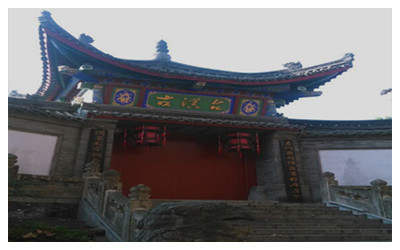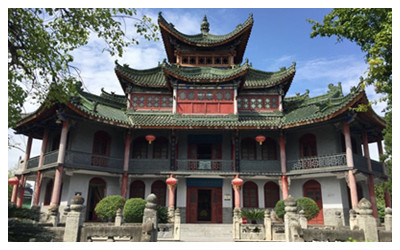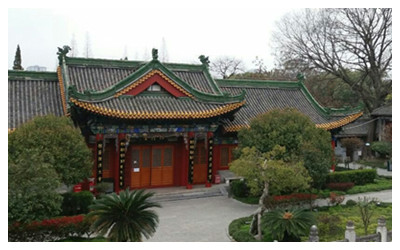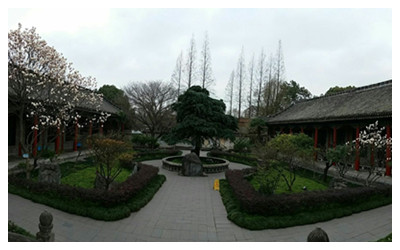Skype: neodalle-travel
Tel: +86 135 7447 2266
E-mail: sales@visitaroundchina.com
What to see?
 The Ancient Hantai
The Ancient Hantai
Walking into the museum, tourists will see a hathpace which is 23 feet (7 meters) high. Facing south, it mainly consists of three mesas, and rises via steps northwards. It was once the royal residence of Liubang when he was demoted to Hanzhong. Afterwards, he defeated his rival, established the Han Dynasty (202 BC - 220 AD), and moved to Changan (nowdays Xian). In order to memorize him, his former residence was named Ancient Hantai and regarded as the 'root' of Han Dynasty by later generations.
Wangjiang Pavilion
Lying on the top of the Ancient Hantai, nowadays, is Wangjiang Pavilion (Watch River Tower) with a height of 60 feet (17 meters). Built in the Southern Song (1127 - 1279) style, it is the ancient landmark building in the  city. It is said that Wangjiang Pavilion was the best location to admire the river in ancient times.
city. It is said that Wangjiang Pavilion was the best location to admire the river in ancient times.
On both sides of the pavilion lie the Bronze Bell Pavilion and Stone Drum Pavilion. An exquisite and priceless bronze bell is placed in the east pavilion. The bell was said to be the relic of the Ming Dynasty (1368 - 1644 AD). The stone drum in the west pavilion is also called Yuetai Beryl, which was the horse-mounting stone of Liu Bang. It is also one of the eight famous scenic spots in Hanzhong.
Guiyin Hall
In front of the Wangjiang Pavilion lies the Guiyin Hall (Osmanthus Shadowed Hall). Tourists can find osmanthus trees in front of the hall. Those osmanthus trees will be in their full bloom when it comes to the mid-Autumn Festival, making the whole place full of osmanthus scent. Inside the Guiyin Hall, tourists can appreciate  historical relics of Han Dynasty. The two buildings to the east and west sides of Guiyin Hall are Donghua Hall and Xihua Hall, which are used to place the relics related to revolution in Hanzhong and ancient paintings and calligraphy respectively.
historical relics of Han Dynasty. The two buildings to the east and west sides of Guiyin Hall are Donghua Hall and Xihua Hall, which are used to place the relics related to revolution in Hanzhong and ancient paintings and calligraphy respectively.
Jingwu Lake
A lake is located to the south of Guiyin Hall, Jingwu Lake (Mirroring Oneself Lake), which was first built in the Qing Dynasty (1644 - 1911). It is rectangle shaped, 40 feet (12 meters) long and 20 feet (5.8 meters) wide. An arch bridge carved with patterns of dragon and tiger can be seen. A poem named Jingwuchi is engraved on a round stone lying beside the lake.
Forest of Stone Stele
 To the south of the Jingwu Lake is situated the south courtyard of Hantai that is also called Forest of Stone Steles, one of the most important groups of collections in the museum. There are two exhibition halls here:
To the south of the Jingwu Lake is situated the south courtyard of Hantai that is also called Forest of Stone Steles, one of the most important groups of collections in the museum. There are two exhibition halls here:
One is Baoxie Plank Road Exhibition Hall which is divided into three parts. The first part shows the trend of seven ancient plank roads leading to Hanzhong from other places; the second displays how the Stone Gate tunnel, world’s first mountain tunnel, was made and the third tells tourists how the post house was set up in ancient times.
Another hall displays the Stone Gate Thirteen Precipice Inscriptions which is praised as national treasure. One world-famous relic is the inscriptions on the cliffs in the Han Dynasty and Wei Dynasty (220-265). It has great value for the study of the development of transport, irrigation, science and technology and calligraphic art in ancient times. It is named as "the Gem of China" and "the Calligraphy Treasury".
Travel Tips
How to get there: Located on No. 26 East Street of Hantai District, visitors can take bus line 9, 21, 22 to get there.
Entrance Fee: free, but all visitors need to get a ticket before entry with a valid ID certificate like passport.
Opening Hours: 09:00-17:30 ( The museum is closed on Mondays except the legal holidays).
 Ask Questions ?
Ask Questions ?